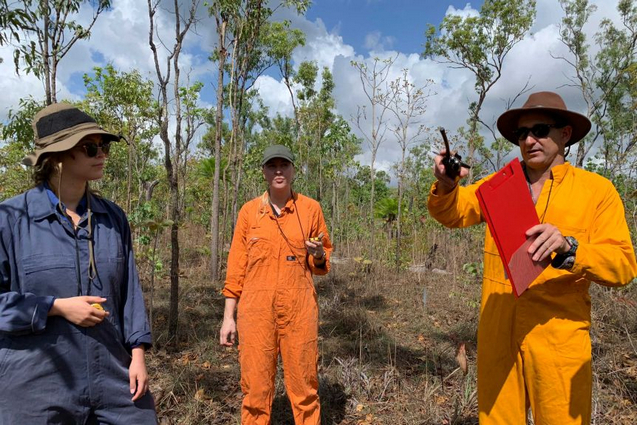 |
| The scientists stand by and monitor the speed at which the fire spreads as part of their study. (ABC News: Jane Bardon) |
But Charles Darwin University associate professor of ecology Brett Murphy, his colleagues and students have been doing this for 17 years.
Associate Professor Murphy is studying how more frequent and intense bushfires are threatening small mammals.
"One of the ways fire affects small mammals is by opening up the understorey, by killing shrubs and small plants, making it easier for feral cats to hunt them," he said.
"We've seen big declines in northern Australia in species including the black-footed tree-rat and brush-tailed rabbit-rat."
On a study site north of Darwin several times a year, the scientists set fire to some of a series of 1 hectare plots of bushland.
They stand inside each plot timing how quickly the fire moves towards them.
 |
| Brett Murphy (right) is studying how bushfires threaten small mammals. (ABC News: Jane Bardon) |
"So you can see a lot of the trees here have been tagged over the last 17 years, to track their fate, whether they die, how much they grow over time and how fire affects that," Associate Professor Murphy said.
As the threat from wildfire has intensified in Northern Australia over a series of hot dry seasons, rural fire services, Indigenous ranger groups and pastoralists are carrying out more controlled burning to protect communities and reduce carbon emissions.
They burn networks of firebreaks into the landscape in the cooler part of the early dry season, when bushfires as less destructive, to prevent hotter out of control wildfires in the late dry season.
As prevention burning has expanded, so has community concern, one of the study's founders Alan Anderson said.
So the scientists have studied how regularly, and what times of the year, areas should be burnt to achieve the best balance between protecting communities, preventing the release of greenhouse gases and preserving biodiversity.
"On our site here we have six different ways of burning, including not burning at all and keeping fire out, and then burning other plots every two, three or five years, early in the year and then we also burn other plots in the late dry season," Professor Anderson said.
 |
| The area is rich with biodiversity, aiding the scientists in their respective studies. (ABC News: Jane Bardon) |
He said the research has found that the best way to protect against wildfires while protecting biodiversity is to burn different areas within a large landscape at different intervals.
"That's the real challenge is to get the balance right to cater for different plant and animal groups that prefer different ways of burning and to make sure that you have those different ways of burning represented somewhere in the landscape," he said.
"So that all the plants and animals can be maintained in the broader region."
 |
| Research shows different levels of burning various areas broadly helps balance biodiversity and carbon. (ABC News: Jane Bardon) |
At the same time, CSIRO research scientist Anna Richards has been studying how much carbon is being stored in the plants, trees and soil on the different plots.
Her work has helped to prove that Indigenous ranger groups across Northern Australia, who were already earning Federal Government carbon credits from stopping wildfires, are also preventing carbon being released from dead trees.
As a result, the Federal Government has just changed its Emission Reduction Fund rules to allow saving these trees to qualify for carbon credits.
"So as fire managers alter the way they burn, burning less frequently and less intensively, that's creating a store of carbon through accumulating carbon in this dead wood on the ground," Dr Richards said.
"That creates an additional source of income for land managers where there's not much other opportunities for economic development in these areas.
 |
| CSIRO research scientist Anna Richards is researching how much carbon is being stored in the plants. (ABC News: Jane Bardon) |
Dr Richards said finding a good balance between maintaining biodiversity and carbon across whole landscapes will become even more important as climate change intensifies.
"We're lucky that in the study period we've had three cyclones, and two of the driest wet seasons on record," she said.
"With climate change, as we get more frequent shorter dry seasons or more intense cyclones, that could change carbon and biodiversity stored in the landscape.
"So that's the real benefit and specialness of running these long term experiments over many years."
Links
- How much preventative burning is too much for biodiversity? (Audio)
- Why are there so many fires burning the Top End black every year?
- Australian Defence Force's prescribed burn on Mount Bundey comes under fire in the Northern Territory
- (AU) Act Now On Wildfires, Global Climate Change, Human Health, Study Says
- (AU) New ANU Centre To Target Bushfires Through Satellites, GPS-Guided Water Gliders
- (AU) Fire Lessons From Australia’s South Coast
- The Tipping Points At The Heart Of The Climate Crisis


No comments:
Post a Comment